Andrew's Station, Los Angeles County, California
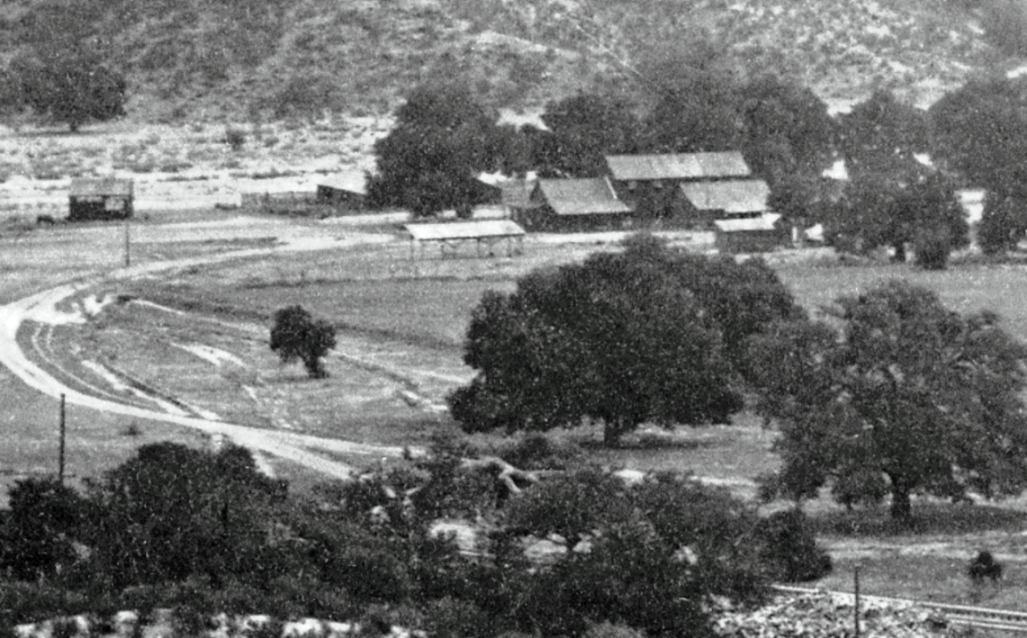
The two story 17-room Andrews Station in 1877 (close-up of photo by Carlton Watkins). You can see the railroad tracks in the lower right.
Andrew J. (1838-?) and Maurice Kraszynski (1837-1918) were brothers originally from Poland. Andrew immigrated to the United States in 1860. By 1868 he was working in Missouri as a salesman. While there, he was naturalized in 1869.
Maurice immigrated to the United States in 1858 was naturalized citizen on September 20, 1866, in New York. Maurice fought in the Civil War from 1861-1865 on the side of the Union in the 11th Regiment, Connecticut Volunteers. He was wounded twice and discharged as a captain. On January 22, 1867, he was appointed as second lieutenant in the Twelfth Regiment of the United States Infantry. In December of that year, he was court-martialed and charged with, among other things, "conduct unbecoming an officer and a gentleman." Maurice was acquitted. On December 6, 1872, he was dismissed from the service, still a second lieutenant. From his last Connecticut Volunteers rank, he was called Captain Kraszynski for the rest of his life. Maurice married Ada F. on March 31, 1873 in Washington D.C. However, she soon left him and moved to New York. He divorced her in Los Angeles on June 9, 1877. In 1875, Maurice ran for the Justice of the Peace in Soledad District, but he apparently lost.
The brothers were running Lyon's Station by December of 1873. The were working for Adam Malezewski, who had bought out Sanford Lyon in 1871. According to newspapers, the Kraszynskis constructed the new station between June and August of 1875. Boring for the San Fernando railroad tunnel had started in March of 1875. No doubt the Kraszynskis wanted to be near the new railroad line, which they probably thought would financially hurt Lyon's Station, which would be bypassed by the railroad. The new station was named for Andrew Kraszynski, the actual owner. According to Maurice (from a future lawsuit - see below for Case 4240), he had no financial interest in the station.
Andrew's Station was located on the south side of today's Newhall Avenue between Pine Street and Needham Ranch Road. It was just east of the Evergreen Animal Center. The station was about a mile northwest of Lyon's Station and located on Rancho San Francisco land. It would initially only be a stagecoach stop but when the Southern Pacific railroad line was completed in August of 1875, it also became a train stop. Southern Pacific also constructed a siding and little depot nearby in anticipation of the planned new refinery (the future Pioneer Oil Refinery) of the California Star Oil Company (Los Angeles Evening Express, October 21, 1876). The siding would allow passengers and supplies to be loaded and unloaded. It would also allow refined oil products from the refinery to be loaded and crude oil for the refinery to be unloaded. The depot would often be incorrectly called Andrew's Station, which was about 1/4 of a mile away (see the below Watkins photo showing both). In the future, after the refinery was no longer in use, a 1000 foot spur line would also be built to service the large oil storage tanks on the hill above the refinery. By 1900, the siding station, with the depot, would be called Elayon.
The Los Angeles Herald of June 9, 1875, reported that:
The Kraszynski Brothers are building a fine house about a quarter of a mile [actually a mile] above their present location at Lyon's Station. It will have seventeen rooms, besides the store-rooms, and when finished there will be a lively house-warming, in about two weeks, to which the proprietors invite their friends."
On December 1st, 1875, Andrew Kraszynski leased the tract of land which contained the station from J. M. (Jose Manuel) Soto for two years at $300 per year. Soto had 1/4 interest in Rancho San Francisco. H.M. Newhall had deeded him that interest in February of 1875 (Deeds, Book 52, Pages 568-570). Whether Kraszynski had leased the land before that date is unknown, but considering that the station was started and finished before December 1st, there must have been some sort of agreement.
Kraszynski added many improvements to the original structure he had built. Besides a hotel with tavern, store and nearby stable, there was an official post office (with Andrew as the Postmaster) and a Wells Fargo & Company Express office. The Andrew's Station post office had replaced the Lyon's Station post office on August 8, 1875.
A doctor also resided there. The Los Angeles Evening Express of October 17, 1876, reported that "Farther on [from Lyon's Station] is Andrew's, kept by the brothers Kraszynski, Andrew and the Captain. The Captain is as jolly and as full of life as of yore. Here Dr. J.P. Ellis holds forth and does the doctor biz for the good people, from San Fernando on the south to Mojave on the north."
From the Los Angeles Evening Express of October 21, 1876:
"Mr. W. A. Brophy writes from Andrew's Station to the Herald as follows: 'After passing the great tunnel, the first station is Andrew's Station. There is a switch here for loading freight, principally oil, the refinery being near. The beautiful valley of the Santa Clara river stretches out from here for many miles, covered with a growth of white oak timber, and fringed by low hills. This magnificent domain is the property of H. M. Newhall, of San Francisco, the celebrated auctioneer, and it is covered by vast herds of cattle and sheep.'"
Here is a description of the land around Andrew's Station from the Santa Barbara Morning Press of January 9, 1877:
"This station of the stage company is of the dreariest. It is on the bare plain, overlooking the river, the view being circumscribed by the hills, which here come down to the water on both sides. A large weather-board hut, like the clerk's box at a weigh bride, for the stable tender and his family, are all that is visible. There is not a square yard of cultivated ground within miles of it. The nearest house down the valley is at least five miles distant, there is no school near, and yet in this lonely spot the present occupant has lived with his wife and young children for two years. There is such a deliberate absence of all adjuncts to home comfort on a spot where so much might be done with but little trouble that one is struck with the circumstance at first sight."
'He is going off?' remarked the driver, somewhat mournfully, after starting. 'I don't wonder at it. Most of them who have been up here begin to mope after a few months, then take to drink; some of them end badly. Life's uncertain hereabouts when a man takes to liquor. This man has been up here two years, and I think he's likely to go off, too. He has been asking about the holidays. He's married. Did you not see the little children knocking about? Well, I can't blame him. Robinson Crusoe was better fixed, for he wasn't tied to one spot like this.' 'But why does he not cultivate a bit of garden ground?' 'Because he hasn't got it. The land about belongs to the San Francisco Ranch; all the land you have traveled through belongs to it. This is only a patch to what Mr. Newhall owns in the State.'"
The writer was talking about the stable tender, not Andrew Kraszynski, going nuts. I have found no evidence that Andrew was ever married. The 1880 US census indicated that he was single.
Nearby, a new refinery was being built as a replacement to the one at Lyon's Station. The Lompoc Record of May 12, 1877, stated that "A new refinery will at once be built". The San Francisco Chronicle of May 28, 1877 reported that:
"The new still being put up at Andrews Station has a capacity of 120 barrels per day, and the works are being constructed so that five more stills of like capacity can be added without having to increase the size of condensers, agitators or buildings. The various portions of the refinery are being admirably constructed to guard against fire, being so isolated that in the event of one portion taking fire, no danger would occur to the whole. The barreling house is to be situated upon the siding which the railroad company have put in here, and will be 1000 feet from the stills, the oil coming down from the agitator in pipes, and can be loaded by quantity."
1877 was a good year for the station. The San Francisco Examiner of April 4, 1877 reported that "Andrews is prosperous through it oil-mills [the oil wells]. It is the depot of the San Fernando petroleum trade. The oil-mills are miles away in the mountains toward the coast, and give promise of immense yield." The San Francisco Chronicle of May 28, 1877 reports:
"At 12:35 the next day [which would be May 25] we reached Andrews Station, and I was much surprised to see so much stir and bustle on the arrival of the train, no signs of any extensive settlement being. Here I disembarked, and found a mail coach ready to take me an eight of a mile from the track to Andrews Station proper. Here was the coming oil town in embryo, the hotel containing a Wells-Fargo agent, Postmaster and Western Union Telegraph operator, besides the office of the Coast Line Stage Company, all of which are supported mainly by the business of the California Star Oil Works Company, who have a refinery at Lyons Station, about three quarters of a mile from here."
Also from the San Francisco Chronicle of May 28, 1877:
"A number of cars containing lumber, bricks and machinery were being unloaded on the siding: boiler-makers were assailing the cars riveting the new stills, and everything around showed that business was being pushed. The whole scene was in marked contrast to Newhall, four miles north, where a large town exists on paper, and the railroad company have built a large depot, while hardly a person is to be seen or any signs of life appear."
This lack of activity in Henry Newhall's town of Newhall may have turned out to be the reason for the demise of Andrews Station, as we shall see.
In July of 1877, J.M. Soto had deeded his 1/4 interest in Rancho San Francisco back to H.M. Newhall (Deeds, Book 56, Pages 237-241), so now Newhall would be in charge of the lease, which was soon up for renewal.
Andrew's brother Maurice was living at the station and had evidently torn down some fences a few miles away, but on land owned by Newhall. Because of this, Newhall refused to renew the lease and threatened legal eviction. Newhall also claimed that no lease renewal terms were previously agreed to and that in September of 1877, he had told Kraszynski that the lease would not be renewed.
Kraszynski wanted the court to force Newhall to renew the lease, so he filed a lawsuit on December 17, 1877, in the County of Los Angeles District Court of the 17th Judicial District (Case 4240). He alleged that it had been agreed that at the end of the lease, he would have the right of renewal for the same terms and conditions as the original lease.
On April 2, 1878, the trial started and on April 30, 1878, Judge Ygnacio Sepulveda decided in favor of Henry M. Newhall. On May 7, Kraszynski motioned for a new trial. The Los Angeles Herald of May 25, 1878, reported that "Ten days further time to prepare and serve statement on motion for new trial." The Los Angeles Herald of August 7, 1878, reports that "Plaintiff [Kraszynski] found guilty of contempt of Court. Ordered that an alias process issue immediately restoring defendant [Newhall] to possession." On November 4th that motion for new trial was denied after required legal papers were not filed in time. A Certificate of Dismissal was filed against Andrew's case on November 24, 1879. That meant that Newhall could not be sued again for the same cause.
The Andrew's Station Post Office was discontinued in March of 1879 (San Francisco Examiner, March 31, 1879).
Why didn't Newhall want to renew the lease? Kraszynski wanted to renew it. Andrew's Station was evidently doing well. Improvements were being planned. However, by 1877 the town of Newhall, with its own railroad depot, was a failure and Henry Newhall planned to move it to a new site closer to Andrew's Station. Newhall also wanted to build his own hotel. In February of 1878, the whole town, with railroad depot, was moved to its present location. The Southern Hotel was soon built in that same year. A successful Andrew's Station would not be good for Newhall's hotel, so he eliminated his only competition. Andrew stayed in the area until early 1885, when he was reported to be in Arizona as a teamster. Maurice moved to San Francisco sometime in the 1880's.
The physical fate of Andrew's Station is uncertain. The Los Angeles Herald of February 15, 1879, mentions the "site formerly occupied by Andrew's Station." Did that mean that the actual buildings were gone? An 1897 LA Herald article says that a picnic was held between the railroad tunnel and Andrew's Station. Was that the actual structure or the site? Either way, after Kraszynski left, Andrew's Station as a business was over.
More information on Andrew's Station can be on the SCVHistory website here.

Here are two 1877 photos by Carlton Watkins (taken in June or July) pasted together by me. Andrew's Station is in the center left distance. A little depot for the siding is in the right foreground, next to the railroad tracks. The site for the refinery is out of view towards the upper right. The photos were evidently never released pasted together (at least I never found one where they were). The two separate prints each had the title of "Andrews Station, S.P.R.R.". That is why the little depot on the right is often called Andrew's Station, which it wasn't. In the future, this siding and depot would be called Elayon. View towards the northeast.
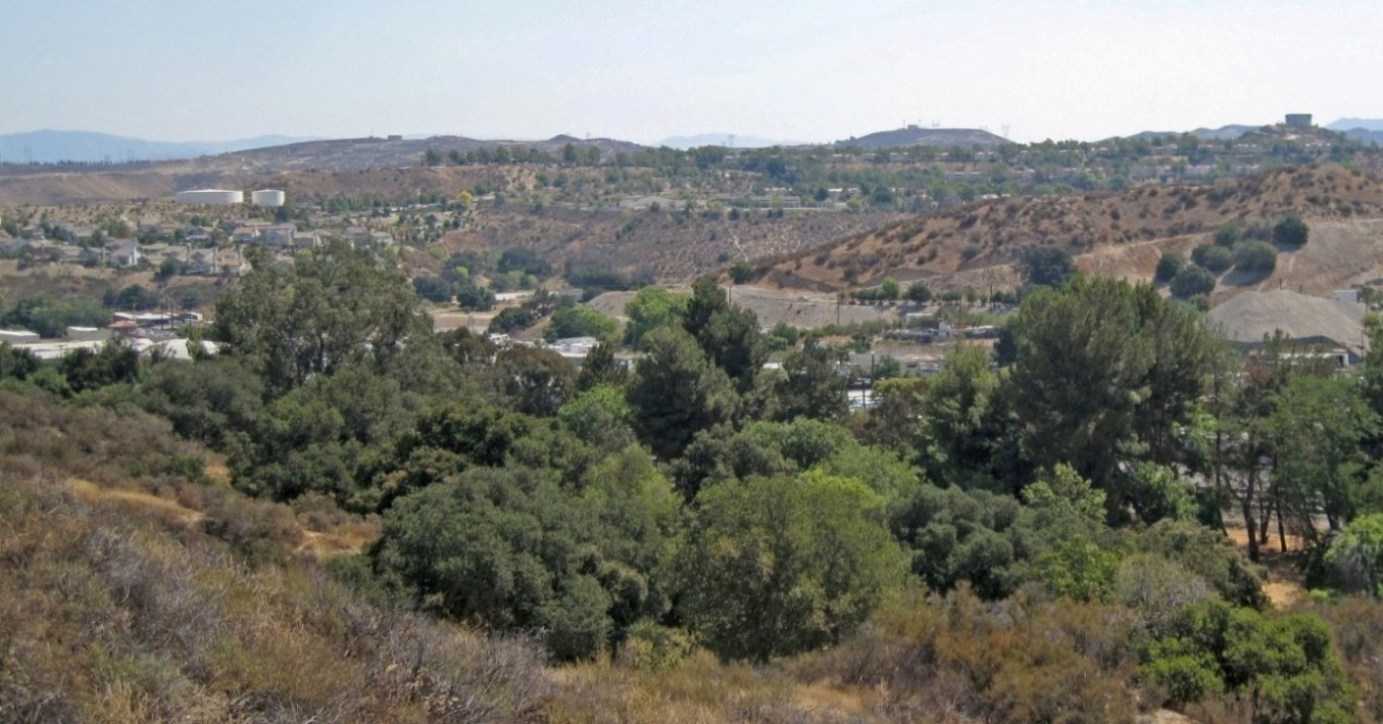
About the same view on June 26, 2016, from the hills above the Hart Park picnic areas on the dirt road past Heritage Junction. You can just make out the railroad tracks through the trees at the lower right.
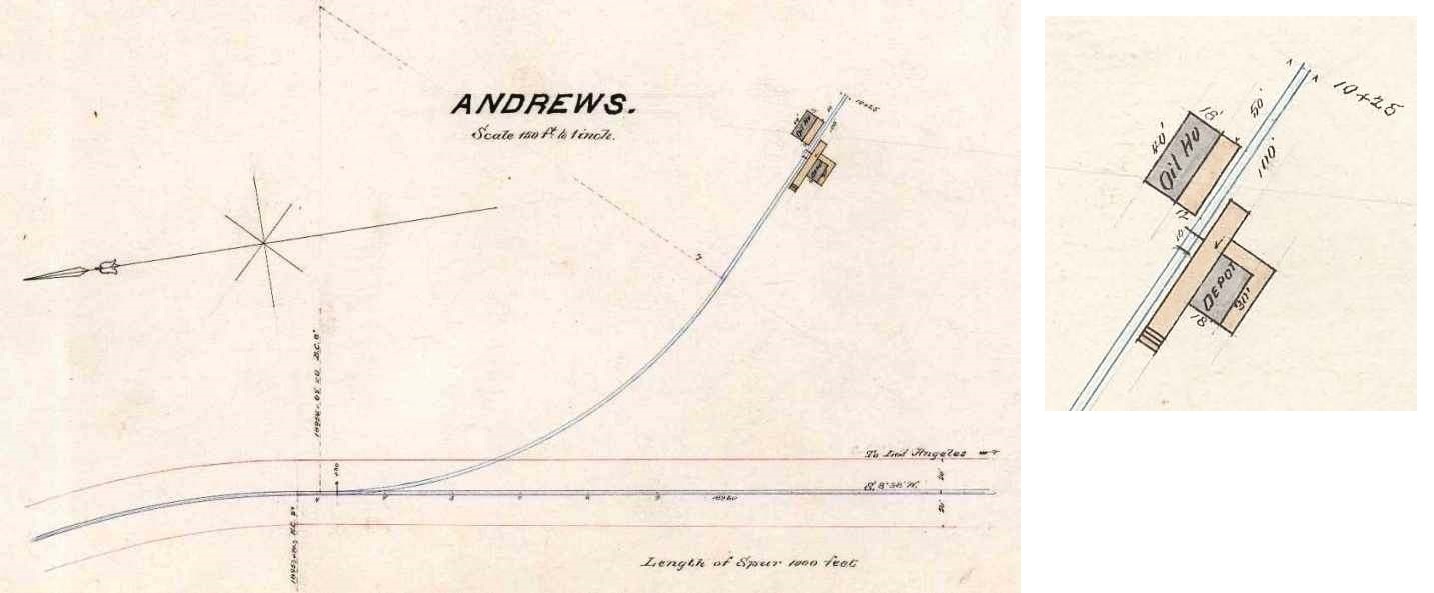
Apparently Standard Oil did have an Andrew's Depot on the spur line, but it was built after Andrew's Station was gone. I'm not sure when the spur line was built. There were still large oil tanks on the hill above the old refiney that were being used for storage by Standard Oil. Here is a map showing the depot at the end of the 1000 foot spur line from the main railroad track. A close-up of the depot and oil house is also shown. The spur was still being used until about 1943 (Don Ball, personal communication). According to Ripley ("The San Fernando Pass and the Pioneer Traffic that Went over It", Historical Society of Southern California, June 1948), the spur was removed in 1948. (Map is from the Map and Drawing Collection of the California State Railroad Museum Library.)
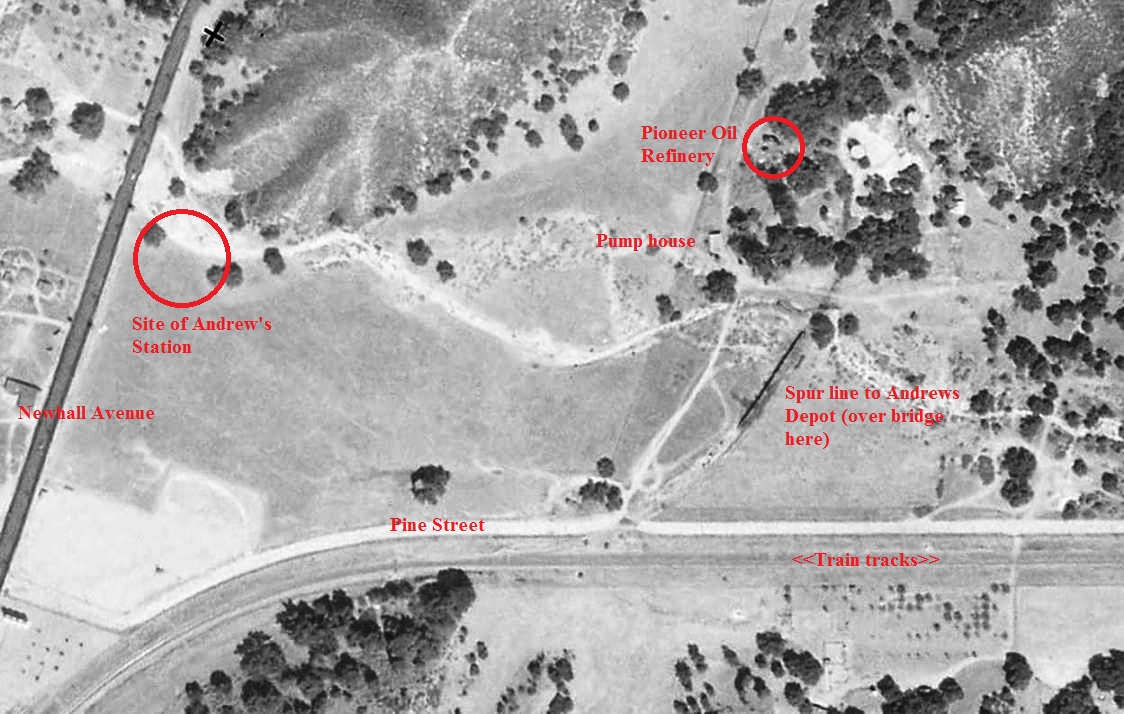
Here is an aerial view from 1930 showing the site of Andrew's Station, the Pioneer Oil Refinery, and the spur line to Andrews Depot. The street names are modern. (Photo from the FrameFinder website of the University of Santa Barbara.)
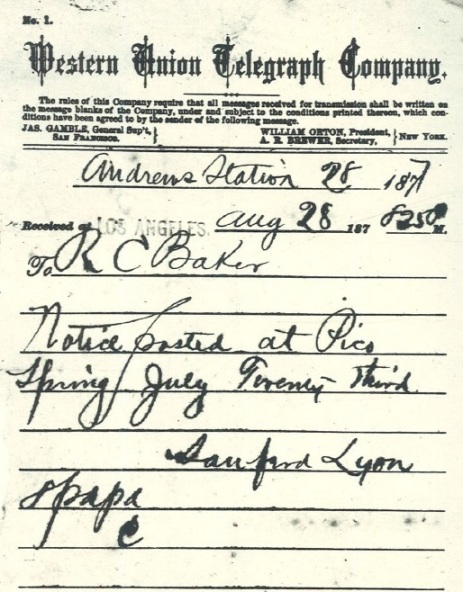
Sanford Lyon to R.C. Baker (actually R.S. Baker) Western Union telegram from Andrews Station on August 28, 1877 (Everette Lee DeGolyer, Sr. papers, DeGolyer Library, Southern Methodist University)
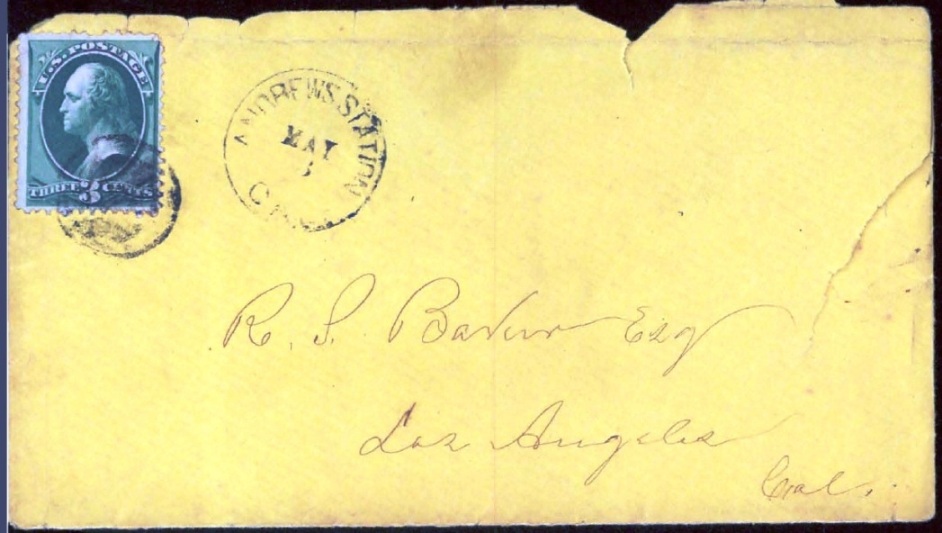
Envelope with Andrew's Station postmark containing May 3, 1878, letter from Sanford Lyon to R.S. Baker (Robert S. Baker papers, Huntington Library)
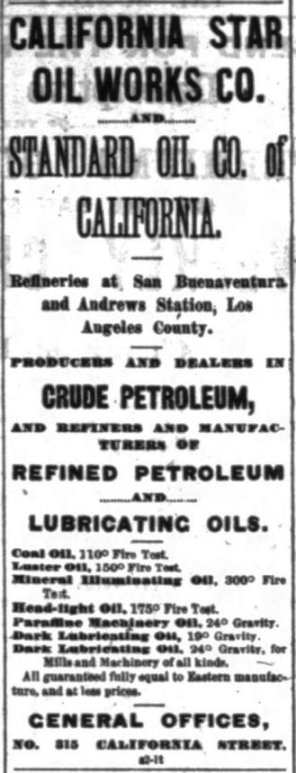
Mention of the Andrews Station refinery of the California Star Oil Works. Ad from the San Francisco Chronicle, October 2, 1877.
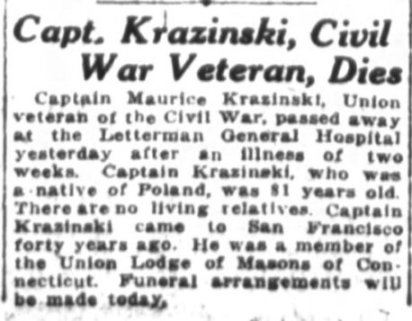
Death of Maurice Kraszynski reported in the San Francisco Chronicle of April 29, 1918. Andrew probably died in Arizona, his last known place of residence, but the date is unknown. Since he was on the 1900 US census, we only know that it was between 1900 and 1918.

The gravestone of Maurice Kraszynski (misspelled as Kraczynsky) is at the San Francisco National Cemetery in San Francisco, California (Photo by Richard Juhl). It is located in Section NA Site 405-A. The "CT" is for Connecticut. During the Civil War he served in the Connecticut Volunteers.










